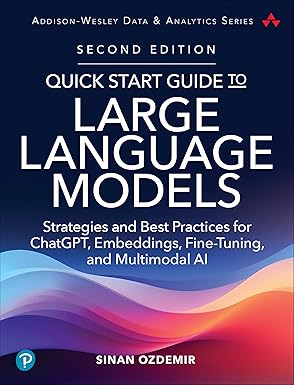Large language models (LLMs) like ChatGPT have become indispensable tools for enterprises, but unlocking their full potential requires strategic implementation. This guide provides actionable insights into optimizing ChatGPT, leveraging embeddings, fine-tuning, and integrating multimodal AI systems. Real-world applications and expertise from Keen Computer and IAS Research further illustrate best practices.
Maximizing Enterprise Potential with Large Language Models
Large language models (LLMs) like ChatGPT have become indispensable tools for enterprises, but unlocking their full potential requires strategic implementation. This guide provides actionable insights into optimizing ChatGPT, leveraging embeddings, fine-tuning, and integrating multimodal AI systems. Real-world applications and expertise from Keen Computer and IAS Research further illustrate best practices.
ChatGPT Optimization Strategies
1. Structured Prompt Engineering
- Delimiters: Use clear delimiters (e.g., triple quotes) to provide context and improve response specificity. Example: Translate the text delimited by triple quotes to French: """Meeting scheduled for Friday at noon."""
- Chain-of-Thought Prompting: Break down tasks into logical steps to enhance accuracy. Example: "Step 1: Extract key data → Step 2: Summarize insights → Step 3: Provide recommendations."
- Few-Shot Learning: Provide relevant examples to help models generate consistent and accurate responses. Example: "Text: 'The system experienced a fault.' | Action: Troubleshoot Error 501."
Use Case: A financial services company uses ChatGPT with structured prompt engineering to generate investment reports based on market data, improving turnaround time by 40%.
2. Hybrid Workflows
- Implement human-in-the-loop validation for AI-generated outputs.
- Apply AI-driven insights while ensuring human oversight in sensitive domains such as legal and healthcare.
Use Case: A legal firm integrates ChatGPT to generate case summaries, with lawyers validating the outputs. This reduces document review time by 60%.
Embeddings & Fine-Tuning
Embedding Best Practices
- Normalize and preprocess data to improve model performance.
- Utilize domain-specific embeddings, like clinicalBERT for healthcare or legal-specific embeddings.
- Deploy vector databases like Milvus for scalable and efficient similarity search.
Use Case: A healthcare provider uses embeddings to retrieve relevant patient data from millions of medical records, reducing diagnosis time by 30%.
Fine-Tuning Checklist
- Set clear goals (e.g., intent recognition accuracy >95%).
- Curate clean, domain-relevant datasets.
- Apply progressive fine-tuning from a base model to task-specific tuning.
- Use fairness metrics such as Equalized Odds to monitor for bias.
Use Case: An e-commerce platform fine-tunes ChatGPT for personalized customer service, increasing user satisfaction scores by 25%.
Multimodal AI Architecture
Key Components
- Data Alignment: Synchronize multimodal data using common time references.
- Encoders: Use CNNs for images, transformers for text, and fusion models for combined analysis.
- Fusion Methods: Apply cross-attention layers for enhanced feature integration.
Efficiency Tactics
- Prune redundant model layers to reduce latency.
- Use late fusion for time-sensitive applications.
- Implement transfer learning using pretrained encoders like ResNet-50.
Use Case: A logistics company uses multimodal AI to analyze shipment images and text reports, improving fraud detection accuracy by 35%.
Implementation Partners
Keen Computer
- Cloud Infrastructure: Deploy RAG systems using Google Cloud with Vertex AI.
- Custom Applications: Develop AI-powered customer support chatbots and legal research tools.
- AI Governance: Ensure compliance with ISO 42001 standards for responsible AI.
Use Case: A telecommunications provider partners with Keen Computer to build a multilingual chatbot for customer support, reducing call center load by 50%.
IAS Research
- AI/ML Research: Innovate in multimodal fusion architecture and contrastive loss functions.
- Compliance Management: Achieve responsible AI certification and mitigate biases.
- Optimization Support: Provide fine-tuning assistance and model pruning services.
Use Case: An insurance company collaborates with IAS Research to build an AI-powered claims processing system that reduces manual effort by 40%.
Strategic Roadmap
- Phase 1: Engage Keen Computer for infrastructure setup and data pipeline development.
- Phase 2: Collaborate with IAS Research for model optimization and multimodal integration.
- Phase 3: Implement human-AI hybrid validation workflows for sustained performance.
By following this structured approach, enterprises can achieve reliable, scalable, and impactful AI deployment, driving tangible business value through the power of large language models.
References
- OpenAI. (2024). Prompt Engineering Best Practices. Retrieved from https://help.openai.com/en/articles/10032626
- Milvus. (2024). Developing Multimodal AI Systems. Retrieved from https://milvus.io/ai-quick-reference
- MarketMuse. (2024). Best Practices for Large Language Models. Retrieved from https://blog.marketmuse.com
- Integral Ads. (2024). Responsible AI Certification. Retrieved from https://integralads.com/responsible-ai
- Keen Computer. (2024). Building Intelligent Applications on Google Cloud. Retrieved from https://www.keencomputer.com
- IAS Research. (2024). Responsible AI Solutions. Retrieved from https://www.ias-research.com
